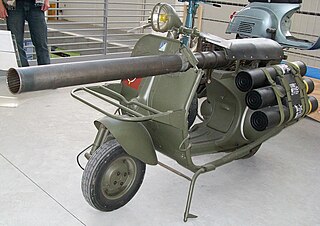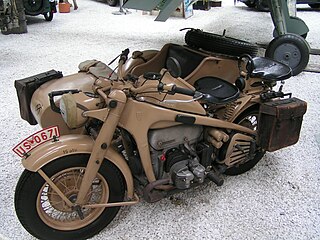 W
WThe Armstrong MT500 is a British military motorcycle made by Armstrong-CCM Motorcycles in Bolton, Greater Manchester, who acquired the rights to the Rotax engine enduro motorcycle SWM XN Tornado from the Italian owners and developed the MT500 for use by the British Army. Electric start models were built for the Canadian and Jordanian armed forces.
 W
WThe BMW R12 and R17 are flat-twin engine motorcycles made by BMW Motorrad from 1935 through 1942. They were developed in 1935 based on the R7 concept of 1934. A few hundred R17s were made, ending in 1937, while the R12 continued through 1942, with a total of 36,008 produced.
 W
WThe BMW R75 is a World War II-era motorcycle and sidecar combination produced by the German company BMW.
 W
WThe BSA M20 was a British motorcycle made by Birmingham Small Arms Company (BSA) at their factory in Small Heath, Birmingham. Although initially viewed as a near failure by the War Office in 1936, the M20 evolved into one of the longest serving motorcycles in the history of British military motorcycling, as well as becoming the most numerous type produced for World War II with 126,000 in active service. Many are still in use around the world today.
 W
WCan-Am is a motorcycle production division of BRP, Bombardier Recreational Products, a Canadian corporation.
 W
WThe FN Tricar was a military motorcycle manufactured before WW2 by FN Herstal of Belgium. As of 2014, around only 7 exist and owned by private collectors.
 W
WThe MT350E is a motorcycle manufactured by Harley-Davidson. A development of the Armstrong MT500 with a smaller capacity engine, electric start and disc brakes.
 W
WThe Harley-Davidson WLA is a Harley-Davidson motorcycle that was produced to US Army specifications in the years during and around World War II. It was based on an existing civilian model, the WL, and is of the 45 solo type, so called due to its 45-cubic-inch (740 cm3) engine displacement and single-rider design.
 W
WThe Harley-Davidson XA was a flat-twin, shaft drive motorcycle made by Harley-Davidson for the US Army during World War II.
 W
WIMZ-Ural is a Russian maker of heavy sidecar motorcycles.
 W
WThe Indian 841 was a motorcycle designed by the Indian Motocycle Manufacturing Co. for desert warfare. It pioneered the drivetrain configuration later popularized by Moto Guzzi, having a longitudinally mounted air-cooled 90-degree V-twin with shaft drive to the rear wheel.
 W
WIndian Motorcycle is an American brand of motorcycles originally produced from 1901 to 1953 in Springfield, Massachusetts, United States. Hendee Manufacturing Company initially produced the motorcycles, but the name was changed to the Indian Motocycle Manufacturing Company in 1923.
 W
WThe Norton 16H is a designation given to British motorcycles made between 1911 through to 1954 with various modifications and refers to a single cylinder Norton 490cc side valve engine with a bore and stroke of 79 x 100 mm. The H denotes the Home model as distinct from the Colonial export model. Norton was the main military motorcycle supplier prior to WW2 and one of the main suppliers of motorcycles to the British Army in World War II with a total of nearly 100,000 produced. British Army Nortons were also supplied to the Commonwealth forces such as Australian, New Zealand, India and the Canadian Army.
 W
WThe Model 1, or more commonly known as Big 4 was a Norton motorcycle made between 1907 and 1954 in various forms. With 633 cc (38.6 cu in), it was the largest and most powerful side valve engine, with plenty of low end torque in the model range, and was mostly used to haul sidecars. Approximately 4700 of the nearly 100,000 military bikes made by Norton during WW2 were Big 4 sidecar outfits. Designed to carry two or three men plus their fighting equipment over very rough terrain, the Big 4 was used for reconnaissance and carrying loads of ammunition to the front line troops. It was called Big 4 due to its power rating of 4 hp, calculated as tax horsepower. Calculated using current methods the horsepower rating would be 14 brake horsepower.
 W
WThe Sokół 1000 was the heaviest Polish pre-war motorcycle manufactured by the PZInż works, for both civilian and military use by the Polish Army. Production of the model 1000 started in 1933 and lasted until the outbreak of World War II in 1939. A standard completion was a sidecar combination.
 W
WThe Triumph Model H is a British motorcycle made by Triumph Engineering Co Ltd in Coventry, England. A total of 57,000 Triumph Model H motorcycles were made from 1915 until production ended in 1923.
 W
WThe Velocette MAC is a British motorcycle made by Velocette. A reliable single-cylinder, the MAC coped well with the low-grade post war petrol and was a popular commuter and touring motorcycle. Although they started as innovators, Velocette failed to keep pace with developing technology and production ended in 1959.
 W
WThe Vespa 150 TAP was an anti-tank scooter made in the 1950s from a Vespa scooter for use with French paratroops. Introduced in 1956 and updated in 1959, the scooter was produced by Ateliers de Construction de Motocycles et Automobiles (ACMA), the licensed assembler of Vespas in France at the time. Modifications from the civilian Vespa included a reinforced frame and a three-inch recoilless rifle mounted to the scooter.
 W
WThe Welbike was a British single-seat motorcycle produced during World War II at the direction of Station IX — the "Inter Services Research Bureau" — based at Welwyn, UK, for use by Special Operations Executive (SOE). It has the distinction of being the smallest motorcycle ever used by the British Armed Forces. Between 1942 and 1943, 3,641 units were built and, although not much used by the SOE, some were issued to the British 1st and 6th Airborne Divisions and some were used at Arnhem during Operation Market Garden.
 W
WZündapp was a major German motorcycle manufacturer founded in 1917 in Nuremberg by Fritz Neumeyer, together with the Friedrich Krupp AG and the machine tool manufacturer Thiel under the name "Zünder- und Apparatebau G.m.b.H." as a producer of detonators. In 1919, as the demand for weapons parts declined after World War I, Neumeyer became the sole proprietor of the company, and two years later he diversified into the construction of motorcycles.
 W
WThe Zündapp KS 750 is a World War II-era motorcycle and sidecar combination developed for the German Armed Forces during the Second World War by the German company Zündapp G.m.b.H.. After entering service in 1941, it served on all the major German battlefronts and was used in a variety of roles.